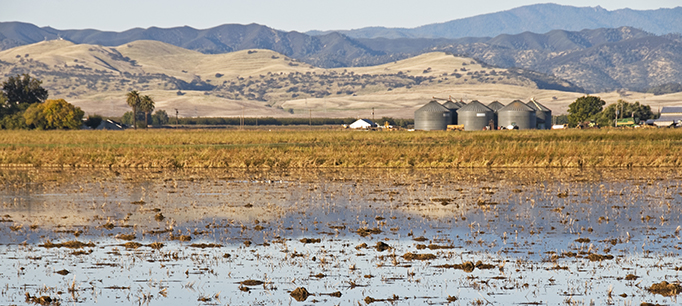What will it take to successfully manage groundwater in California? This was the topic of a recent workshop jointly held by UC Water and the PPIC Water Policy Center. The workshop brought together researchers, policy makers, and water managers to reflect on the challenges of implementing the Sustainable Groundwater Management Act in California’s Central Valley, the state’s leading agricultural region. Here are some key takeaways.
- Groundwater recharge should become more intentional. Farmers are the biggest users of groundwater in the Central Valley—but they also do the most to replenish it. When they apply water to their fields, crops don’t use all of it—some water seeps down and recharges underground aquifers. However, to achieve sustainable use in many aquifers, the process of recharge will have to become more deliberate and widespread in the Central Valley. UC Water experts presented research from several experimental sites across the state showing that recharge can be increased in a variety of ways. Depending on local circumstances, some possible solutions include having farmers flood their fields with excess winter runoff, setting back levees and using floodplains as infiltration grounds during flooding, and engineering recharge basins or using injection wells to direct water underground. Some of this is already happening in different parts of the valley. But scaling up recharge efforts to a magnitude large enough to bring overdrafted basins into balance will likely mean developing hundreds of additional small, decentralized projects across the valley.
- It’s all about incentives. Recharge is a local process, but the benefits can be regional. To make recharge projects sprout in the Central Valley, incentive mechanisms will be needed to credit individuals who participate. One promising way of incentivizing farmers to recharge was presented by UC Santa Cruz researcher Andrew Fisher, who described experiences from a pilot project in the Pajaro Valley on California’s Central Coast. That project’s goal is to establish a system that provides rebates to those who recharge groundwater.
- Accounting will be critical.California’s groundwater law requires users to establish local groundwater sustainability agencies (GSAs), which will have authority to monitor, measure, and regulate pumping and to fund recharge projects. Before passage of the law, California generally did not require monitoring of groundwater pumping or restrict its use, despite continued declines of groundwater levels in many parts of the state. As a result, there is little historical data on groundwater pumping and storage for Central Valley groundwater basins. At least some GSAs are likely to begin metering agricultural pumping, which can serve both as monitoring and enforcement. As GSAs make these important decisions, it will be important for them to strive for having widely available, transparent estimates of groundwater use and recharge volumes. Such data are critical to estimate groundwater budgets and provide a framework for water trading. For instance, crediting farmers for recharge is impossible if we don’t know how much water they pump out and how much they recharge.
- No silver bullets. While recharge is promising, some reductions in groundwater use may also be necessary to achieve sustainability in some areas. For example, in parts of the southern Central Valley, there may not be enough extra surface water to justify building new recharge infrastructure. Many places across the valley may not have the right soil composition for recharge. Fortunately, California has extensive infrastructure to move surface water from where it is more plentiful to where it is scarce. As locals begin to implement the groundwater law and seek to reduce overdraft, water trading can help increase the efficiency and reliability of water allocation.
The workshop showed that there is a high level of interest in discussing solutions to California’s groundwater management challenges. Finding more opportunities to bring researchers and practitioners together to discuss ongoing work and identify ways to collaborate is an important step forward in the state’s path toward sustainable groundwater management.
Read “The Coming Groundwater Revolution” (PPIC Blog, January 6, 2016)
Read our policy brief “California’s Water: Storing Water” (from California’s Water briefing kit, April 2015)
Visit the PPIC Water Policy Center



